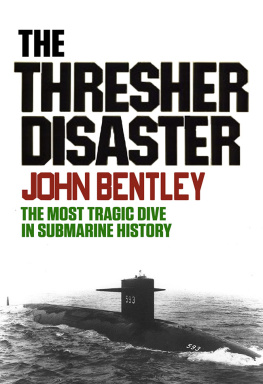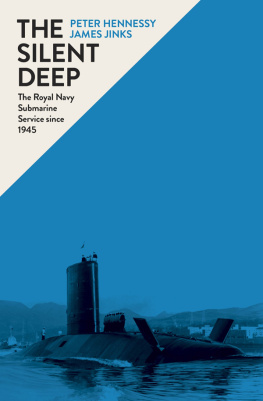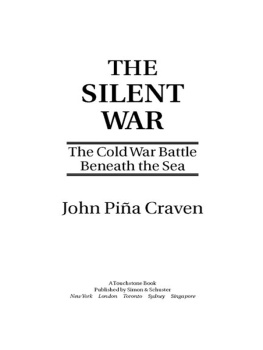Jerry eBooks
No copyright  2015 by Jerry eBooks
2015 by Jerry eBooks
No rights reserved. All parts of this book may be reproduced in any form and by any means for any purpose without any prior written consent of anyone.
By the same author
WHERE ARE THE RUSSIANS?
THE FASTER THEY GO
Credits
Photos 1-15, 18-26, 27-35: Official Photograph, U.S. Navy
16, 17: Official Photograph, Courtesy Ingalls Shipbuilding Division, Pascagoula, Mississippi, who built the USS Dace; U.S. Navy
26A: Courtesy of the Woods Hole Oceanographic Institution
Charts 37, 38: Bathymetric data from the search for the USS Thresher, by R. J. Hurley, charts (Fig. 2 and Fig. 8), were first printed in International Hydrographic Review, Vol. XLI, No. 2, July 1964.
Map 39: Courtesy the American Society of Naval Engineers, Inc., The Naval Engineers Journal, August 1965.
excerpts from Search for the Thresher copyright 1964 by Norman Polmar from THE UNDERWATER SOCIETY OF AMERICA. Reprinted by permission of Chilton Book Company.
excerpts from Navy Held Thresher Facts 18 Months by Luther J. Carter, article appeared in Jan. 10, 1965 issue of the Washington Post. Copyright 1965 by The Washington Post Company. Reprinted with permission.
Library of Congress Cataloging in Publication Data
Bentley, John, 1908
The Thresher disaster.
1. Thresher (Submarine) I. Title.
VA65.T47B46 623.8885
ISBN 0-385-03057-6
Library of Congress Catalog Card Number: 73-20507
Copyright 1974, 1975 by John Bentley
All Rights Reserved
Design/Geoffrey Marshall
Printed in the United States of America
First Edition
In persons grafted with a serious trust, negligence is a crime.
William Shakespeare
The opinions and assertions contained in
this book, except where they are quota
tions taken from official documents, are the
private ones of the writer. They are not to
be construed as official or as reflecting the
views of the U.S. Navy Department or the
naval service at large.
Inboard Profile
USS Jack SSN -605, identical to USS Thresher SSN -593 except that engine-room is 10 ft longer to accommodate large turbine. Two contrarotating propellors driven by a shaft within a sleeve-like shaft utilize a 10 per cent power increase. Aft of Sonar sphere, Thresher was divided into five compartments.
A SONAR SPHERE: sonar transducers normally flooded in sea water.
B FORWARD COMPT: Upper level, Main Ballast Tanks 1 & 2. Escape Hatch. 2nd level, Forward Crews Quarters (3-man bunks) & Emergency uqc. 3rd level, Electronic Spare Parts Stowage; Sonar Equipment Room; Diesel Generator Room. Lower Level, Forward Trim Tank; Main Ballast Tanks 1 & 2; Collection Tank.
C MIDSHIP COMPT: Upper Level, Ships Control Center (C.O.s post at time of disaster), where ships attitude, depth, surface or submerged controls are located. Also, periscope, fire control equipment & main uqc. Electronic Equipment Space (basically a Sonar Information Center); Radio Room (ships external communications equipment) & Fan Room. 2nd level, Crews Washroom; WRSR No. 2 (Wardroom-Stateroom of Lyman, Henry & McCoole); WRSR No. 4 (three other officers); Executive Officers Stateroom (Gamer); Commanding Officers Stateroom (Harvey); Officers Wardroom; Dry Provisions Store Room. 3rd level, Crews Quarters (10-man Bunk Room); Torpedo Room (storage & torpedo tubes); Air Regeneration Room. Lower Level, Sanitary Tank No. 1; Pump Room (Trim, Drain or Bilge pumps; various cooling system pumps); Battery Compt (ships emergency battery for light & propulsion); Auxiliary Tanks (filled with sea water to maintain neutral buoyancy); Diesel fuel oil tank.
D REACTOR COMPT: Upper Level, Reactor Tunnel, heavily shielded, for access to Auxiliary Machinery Room. 2nd level, Reactor; auxiliary components & steam generators; normal fuel oil Tank No. 2 inside shielding. (Possible contributing factor to explosion following implosion.)
E AUXILIARY MACHINERY ROOM: Upper Level, Main Ballast Tanks 4,5 & 6. Rear Escape Hatch. 2nd level, Ships main electrical panels & bussing. 3rd level, Pumps & complex auxiliary sea water system, (probably where minor difficulty occurred). Lower Level, Main Ballast Tanks 4, 5 & 6.
F ENGINE ROOM: Threshers largest compt, housing ships main turbines; main condenser; SSTG (Ships Service Turbine Generator); feed water systems pumping condensed water back to steam generator; main sea water cooling system. Upper Level, Engineering Control Panels (Reactor Control, Steam, Feed Water & Electrical Control Panels). McCooles position. Lower Level, Reserve Feed Water Tank; Main Lube Oil Sump; sstg Oil Sump; Lube Oil Stowage Tanks; After Trim-Tank; Main Ballast Tank No. 7.
THE LAST 24 HOURS
April 9, 1963
During the early hours of Tuesday morning, April 9, 1963, weather reports held the promise of a bright day with moderate seas. The wind rippled the darkened waters of the Piscataqua River, however, still carrying the chill bite of winter.
Lying quietly at her berth alongside Pier 11 in Portsmouth Naval Shipyard, New Hampshire, the long, sleek shadow of USS Thresher (SSN-593) gave no hint of the activity going on inside her 278-foot hull. But aboard it was a different story. The interior of the Navys newest, fastest, deepest-diving, and most lethal nuclear attack submarine was ablaze with lights. The constant clatter of footsteps echoed along her seemingly endless passageways or clanged up and down the rungs of her steel ladders. Everyone was busy with some chore, either finding their way around or helping to get the ship ready for her first shakedown cruise after a nine-month overhaul, much of that time in dry dock.
Thresher was way overcrowded. Besides her regular complement of 12 officers and 96 enlisted men, she carried 21 observers. These included three officers and 13 civilian employees of Portsmouth Naval Shipyard, one officer from the staff of the Deputy Commander, Submarine Force, Atlantic Fleet, and four civilian contractor representatives. Finding bunks for all these guests was no mean job. Since, however, the skids in Threshers Torpedo Room were not in use (she carried no weapons), this compartment down on the third level (see Profile), which spanned the width of the ship, had been turned into sleeping quarters by bolting bunks to the skids. These had to be secured because of the large angles (sharp turns and dives during maneuvers). Some 30 of these bunks were made up in the Torpedo Room, which gives a good idea of the size of this compartment.
But no one cared. To a man, the ships company was interested in seeing Thresher put through her paces during the next 48 hours. By Thursday, April 11, she would be back at Pier 11, with most of the thousand items on her Sea Trial Agenda checked off as satisfactory or requiring nominal attention. So everyone hoped.
It was now 0615 and











 2015 by Jerry eBooks
2015 by Jerry eBooks